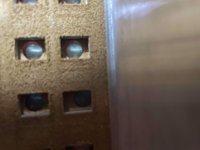Bloviator
Member
I have a relatively new accordion that is leaking enough air to interfere with playing. If I drop the bellows from full extension, it takes about 3 seconds to close and some notes sound on the treble side. Which notes seems to depend on what register is selected.
The gasket seal is intact and pliable with a tight fit on both sides. Pins are tight.
The base side valves and blocks are in good condition. Covering the holes with paper made no difference.
On the treble side again the valves are fresh, but I did not take the blocks out.
Under the grill it appears there is good contact with the pallets and a paper drags on all corners.
I can hear the faint sound of air leaking, but when I get close to the locations I have mentioned, it seems to not originate from there.
Are there other easy locations to look in? I lack a lapel mic and a stethoscope as is suggested elsewhere.
The gasket seal is intact and pliable with a tight fit on both sides. Pins are tight.
The base side valves and blocks are in good condition. Covering the holes with paper made no difference.
On the treble side again the valves are fresh, but I did not take the blocks out.
Under the grill it appears there is good contact with the pallets and a paper drags on all corners.
I can hear the faint sound of air leaking, but when I get close to the locations I have mentioned, it seems to not originate from there.
Are there other easy locations to look in? I lack a lapel mic and a stethoscope as is suggested elsewhere.



